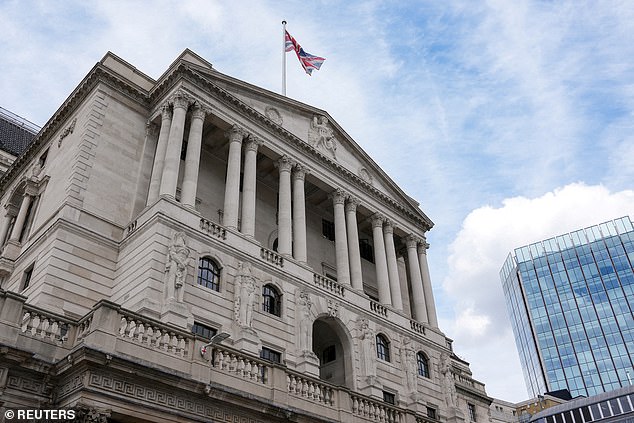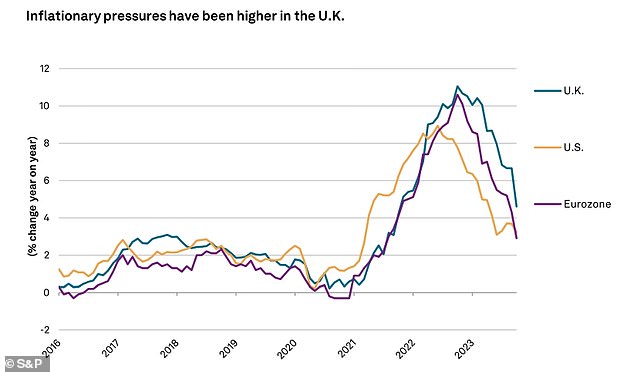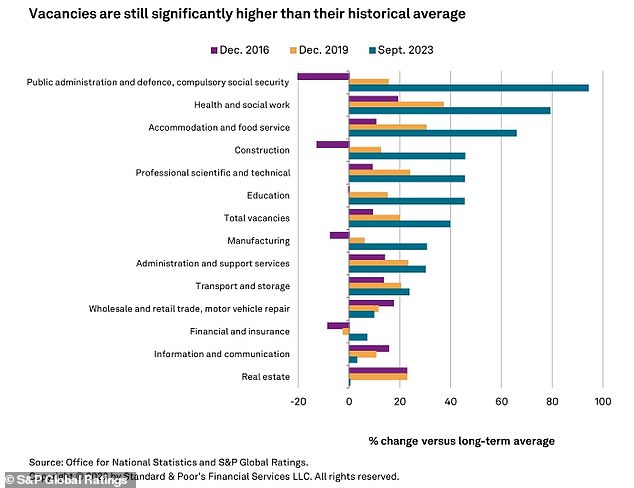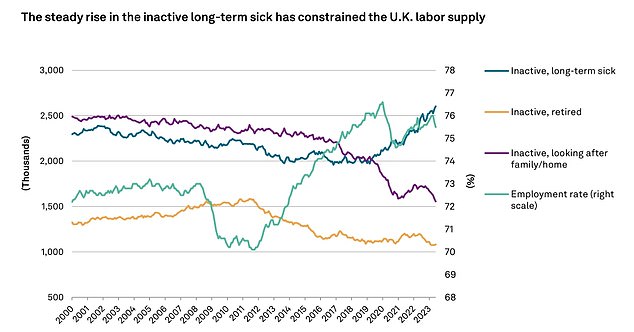- Falling inflation has driven expectations of interest rate cuts next year
- S&P says hikes are yet to have an impact and need to stay higher for longer
- Britain’s stubbornly tight labour market is set to keep inflation above target
UK interest rates will have to remain higher for longer in order to drag inflation back to the Bank of England’s target of 2 per cent, analysts at S&P Global Ratings have warned.
A new S&P forecast says the BoE will not begin cutting base rate from its current level of 5.25 per cent until the second half of next year.
The US-based credit ratings agency said the impact of previous hikes has yet to fully feed through to the economy and the country’s stubbornly tight labour market continues to prop the inflation rate higher.
As a result, S&P said, Britain faces ‘yet another year of economic weakness in 2024 with GDP growth of just 0.4 per cent, as interest rates remain restrictive for an extended period’.

S&P says the Bank of England will have to hold interest rates higher for longer
Consumer price inflation slowed from 6.7 per cent to 4.6 per cent in October, driving expectations that the UK base rate has now peaked and rate cuts could soon be expected.
A softer inflation print, combined with evidence of a loosening jobs market, falling wage growth and weaker economic output, even pushed Goldman Sachs to suggest the first rate cut could come as soon as February 2024.
But the BoE last week warned that City expectations of an interest rate cut were ‘underestimating’ the persistence of inflation.
Governor Andrew Bailey told MPs that traders were placing ‘too much weight’ on recent figures showing that inflation has plunged to less than 5 per cent.

UK inflation remains higher than peers
Senior economists at S&P Global Ratings, Marion Amiot and Boris S Glass, said: ‘Even though headline inflation has now eased markedly, core price pressures persist. This has taken its toll on households’ purchasing power.
‘At the same time, higher interest rates are incentivizing consumers to save more and delay major purchases and investment decisions. The labour market remains tight, encouraging dynamic wage increases.
‘The UK’s exit from the EU single market, an boost in the number of the long-term sick, and workers’ changing job preferences due to the pandemic have all contributed to this.
‘The tightness means that monetary policy will have to remain restrictive for longer to return the inflation rate to 2 per cent on a sustainable basis.’
Mark Haefele, global wealth management chief investment officer at UBS, also noted on Monday that data showing better than expected business activity has also dampened expectations of impending rate cuts.
He said: ‘The chance of a rate cut by June from the Bank of England is down from 97 per cent on 20 November to 36 per cent.
‘The swings in market expectations for future interest rates are in line with our view that market sentiment over the timing and pace of rate cuts will continue to swing. But we believe a turning point for central bank policy is near.’

The labour market remains stubbornly tight

Long-term sickness has been a key driver




